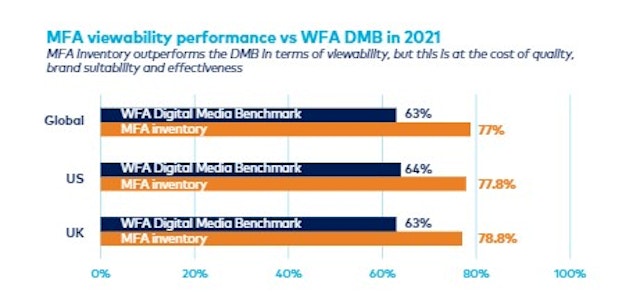10% of US programmatic ad spend is wasted on ‘made for advertising’ sites
Almost 10% of programmatic ad spend in the US goes to low-quality, low-value websites designed to trick advertisers, according to a study from Ebiquity.

Sites that game viewability stats and underdeliver for advertisers are on the rise / Kenny Eliason
The research demonstrates that a sizeable proportion of all ad spend among its clients lands on ‘made for advertising’ (MFA) content. From a sample of 42 Ebiquity clients, which spent a combined $1.47bn programmatically between January 2020 and March 2022, Ebiquity found at least $115m was ‘wasted’ on MFA sites. That’s about 7.8% of their programmatic budget globally and 9.8% in the US.
Ebiquity’s study didn’t specify the clients involved in the sample, but its website lists major advertisers including L’Oréal, Nestlé and Audi.
Why is this still a problem?
While MFA content typically outperforms other sites in terms of viewability, it does so by significantly underperforming in other areas.
According to the report, MFA sites are attractive for DSPs because they deliver above-average results. It found MFA domains deliver a viewability rate of 77% on average, compared with 63% per the World Federation of Advertisers’ digital media benchmark.
In effect, those sites play upon the industry’s desire for high viewability for digital ads, while undercutting the reasons why advertisers desire that viewability such as quality content.
Typically they flood the page with ad units, which dilutes what little value was created by the actual article in the first place. As a result, while one KPI is seen as being met, it means that inventory underperforms. Worse still, it means there is a financial incentive for other MFA content providers to create those unsafe environments.

According to Ebiquity, that behavior is currently a blind spot for most major ad verification platforms. MFA sites typically buy web traffic through sponsored posts (“often clickbait”), placing a high volume of ads in viewable areas, which technically meets the requirements for the verification platforms.
Francesa Leronni, group director of responsible media at Ebiquity, argues that as clients look to avoid funding disinformation through advertising, the need to clamp down on loopholes such as MFA becomes more vital. “Consumers’ expectations have changed, and we are seeing more and more marketers using data to identify and act on poor practices from partners, platforms and publishers.
“Advertisers have to leverage data and technology to create reportability, and thereby power principle-driven growth.”
As of the latest report, over $1m of programmatic advertising investments were delivered on websites classed as ‘worst offenders’ for harmful disinformation, according to the Global Disinformation Index.
As a result, 39% of marketers said they cut spending with a major platform last year, with 54% citing the prevalence or presence of misinformation and hate speech as a major factor. Ebiquity includes climate change denial and discriminatory content among those definitions.
To counter that, Ebiquity recommends that advertisers strive to create a clear overview of supply partners and where their ad spend ends up, in addition to reallocating spend to partners that align with value and have demonstrably responsible practices where necessary.

